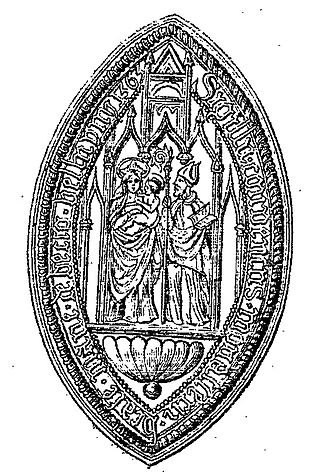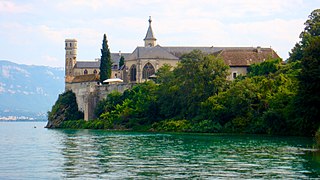
Senones Abbey (Abbaye de Senones) was a Benedictine abbey located in the valley of the Rabodeau, in the present village of Senones in Grand Est, France.

Senones Abbey (Abbaye de Senones) was a Benedictine abbey located in the valley of the Rabodeau, in the present village of Senones in Grand Est, France.
The abbey was founded in the middle of the 7th century by Saint Gondelbert, bishop of Sens, who was also the first abbot. Gondelbert arrived in the Rabodeau valley and named his monastery after the diocese of Sens (Senonis in Latin). [1] In 661, Childeric II, king of Austrasia, donated the Val de Senones to Gondelbert, [2] who dedicated the church to Notre Dame. The monks followed the Rule of Saint Benedict .
The Vögte ("advocates"), from at the latest the 12th century, were the Counts, later Princes, of Salm, in whose lands the abbey stood. There was frequent conflict between the abbey and its Vögte up the end of the monastery's existence. In the 16th century however the conflicts became so severe that to resolve them required the intervention of Emperor Maximilian II and Popes Pius V and Gregory XIII; the resolution was not to the advantage of the abbey, which found itself from then on significantly weakened in relation to the claims of the Salms.
In the 12th century the abbey premises were rebuilt by abbot Anthony of Pavia, and included a round church, now vanished. At this time the abbey was responsible for the foundation of several small priories, including those at Xures, Léomont and Vic-sur-Seille (all in the first third of the century), Le Moniet (1126) and Fricourt (in the mid-12th century). The priory at Mervaville was a later foundation of the abbey, from the first quarter of the 13th century.
The abbey was the home during the first half of the 13th century of the monk and chronicler Richer of Senones. He started to write his Gesta Senoniensis ecclesiae shortly after 1254 and continued his account up to 1264. [3]
The reform of the Congregation of St. Vanne was introduced in 1618. [4]
Dom Antoine Calmet, famed for his extensive commentaries on the Bible, and author of other works including a history of Lorraine, was elected abbot in 1729. (He also left a history of the abbey in manuscript). [5] Voltaire was an admirer of the abbot, and stayed at Senones Abbey in 1754. Dom Calmet assembled a library of 15,000 volumes, and rebuilt the entire complex.
On 2 March 1793 the Principality of Salm was incorporated into the newly formed department of Vosges and at that time the abbey was dissolved.
The abbey's assets were sold off as national property. The buildings were bought by local industrialists who used them for textile works, which is what they remained until 1993, when they were acquired for preservation.
The buildings on the site today are all from the 18th century rebuilding under Dom Calmet, except for (a) the church, a 19th-century reconstruction apart from its bell tower, which is the only structure on the whole site remaining from the 12th century, and (b) the individual houses to the north, also 19th century, which stand on the sites of the old mill and a farm building.
The abbey has been listed as a Monument historique by the French Ministry of Culture since 1983. [6]

Bec Abbey, formally the Abbey of Our Lady of Bec, is a Benedictine monastic foundation in the Eure département, in the Bec valley midway between the cities of Rouen and Bernay. It is located in Le Bec Hellouin, Normandy, France, and was the most influential abbey of the 12th-century Anglo-Norman kingdom.

The Tironensian Order or the Order of Tiron was a medieval monastic order named after the location of the mother abbey in the woods of Thiron-Gardais in Perche, some 35 miles west of Chartres in France). They were popularly called "Grey Monks" because of their grey robes, which their spiritual cousins, the monks of Savigny, also wore.

Antoine Augustin Calmet, O.S.B., a French Benedictine monk, was born at Ménil-la-Horgne, then in the Duchy of Bar, part of the Holy Roman Empire.

Affligem Abbey is a Benedictine abbey in the municipality of Affligem, Flemish Brabant, Belgium, 19 km (12 mi) to the north-west of Brussels. Dedicated in 1086, it was the most important monastery in the Duchy of Brabant and therefore often called Primaria Brabantiae.

Ferrières Abbey was a Benedictine monastery situated at Ferrières-en-Gâtinais in the arrondissement of Montargis, in the département of Loiret, France.

Hautecombe Abbey is a former Cistercian monastery, later a Benedictine monastery, in Saint-Pierre-de-Curtille in Savoie, France. For centuries it was the burial place of the members of the House of Savoy. It is visited by 150,000 tourists annually.

Ligugé Abbey, formally called the Abbey of St. Martin of Ligugé, is a French Benedictine monastery in the Commune of Ligugé, located in the Department of Vienne. Dating to the 4th century, it is the site of one of the earliest monastic foundations in France. The original abbey having been destroyed during the French Revolution, the current monastic community dates from 1853, and belongs to the Solesmes Congregation.

The Abbey of Saint-Germain d'Auxerre is a former Benedictine monastery in central France, dedicated to its founder Saint Germain of Auxerre, the bishop of Auxerre, who died in 448. It was founded on the site of an oratory built by Germanus in honor of Saint Maurice.

Triors Abbey is a Benedictine monastery located in Châtillon-Saint-Jean in the Drôme, Rhône-Alpes, France.

The Diocese of Saint-Dié (Latin: Dioecesis Sancti Deodatiis; French: Diocèse de Saint-Dié is a Latin Church ecclesiastical territory or diocese of the Catholic Church in France. The diocese has the same boundaries as the département of the Vosges. The bishop's cathedra is Saint-Dié Cathedral in the town now named Saint-Dié-des-Vosges, but since 1944 has lived in Épinal, capital of the département. The Diocese of Saint–Dié is a suffragan diocese in the ecclesiastical province of the metropolitan Archdiocese of Besançon.

La Trappe Abbey, also known as La Grande Trappe, is a monastery in Soligny-la-Trappe, Orne, France. It is known for being the house of origin of the Trappists, to whom it gave its name.

Moyenmoutier is a commune in the Vosges department in Grand Est in northeastern France.
Saint Gondelbert, was the founder of the Benedictine Senones Abbey in the Rabodeau valley of the Vosges mountains around 640 AD.
Richer of Senones was a monk and chronicler of Senones Abbey in Lorraine, a traveller and one of the very few chroniclers or historians of the Vosges whose works have survived complete.
The Congregation of St. Vanne or Congregation of St. Vanne and St. Hydulphe (French: Congrégation de Saint-Vanne et Saint-Hydulphe was a Benedictine reform movement centered in the Duchy of Lorraine. It was formally established in 1604 on the initiative of Dom Didier de La Cour, prior of the Abbey of Saint-Vanne near Verdun, a reformer of the Benedictine Order after the Council of Trent. The Abbey of St. Hydulphe at Moyenmoutier was a secondary centre of the reform.

Frigolet Abbey — The Pontifical Shrine of Our Lady of Good Remedy and Saint Joseph is a grand Premonstratensian monastery complex in southern France. It is located in the territorial commune of Tarascon, in the region of the Montagnette, the parishes of which are served by the canons of the monastery. It was originally associated with the Order of Saint Benedict.

Moissac Abbey was a Benedictine and Cluniac monastery in Moissac, Tarn-et-Garonne in south-western France. A number of its medieval buildings survive including the abbey church, which has a famous and important Romanesque sculpture around the entrance.
The Abbey of Saint-Pierre-le-Vif was a Benedictine monastery just outside the walls of Sens, France, in the Archdiocese of Sens.

Montiéramey Abbey is a former Benedictine abbey at Montiéramey, in France, in the department of Aube, in France. It was partly destroyed during the French Revolution; the surviving buildings are now private dwellings.

The Abbey of St. Maurice and St. Maurus of Clervaux, founded in 1890, is a Benedictine monastery in Clervaux, Luxembourg. It is a member of the Solesmes Congregation in the Benedictine Confederation.